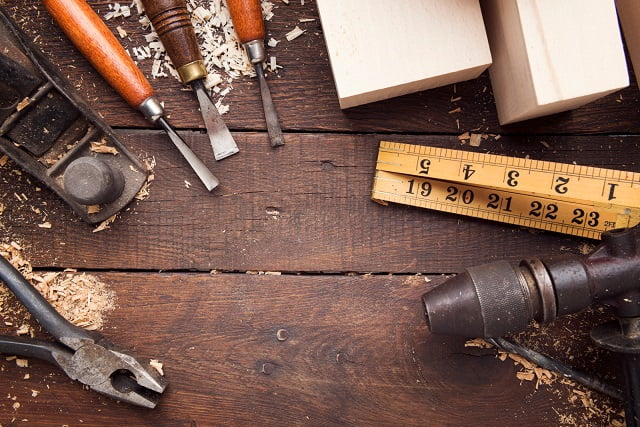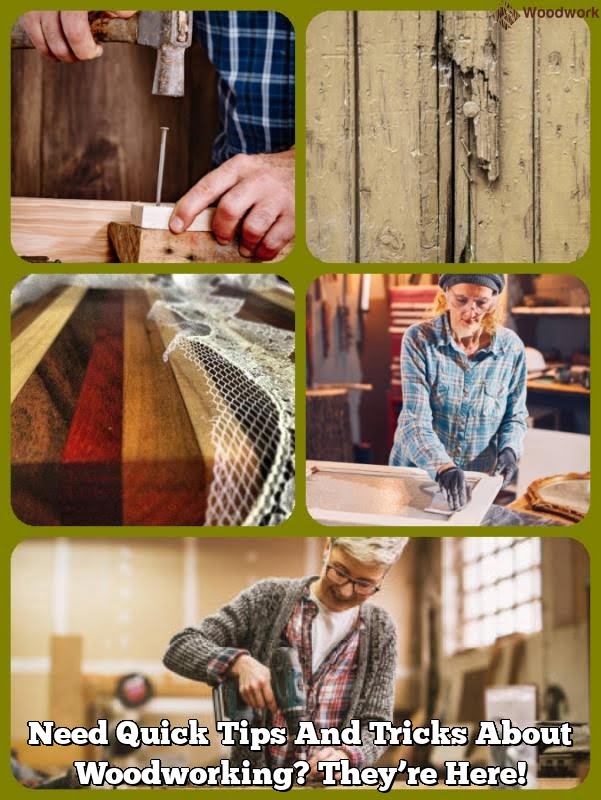
Woodworking tips and tricks are a great way for you to expand upon your skill set as a novice or even experienced woodworker. Not only will you benefit from being able to tackle bigger projects, but you may also find out some useful shortcuts when tackling those jobs that seem too complex or time consuming.
Whether it is the choice of materials, best practices for cutting, or simply improvised solutions for certain problems – here are 5 essential woodworking tips and tricks that you should consider mastering.
Learning Different Types of Cuts Making accurate cuts is an important factor when it comes to woodworking. There are a few different types of cuts that should be mastered before attempting any project. Among the most common ones include mitre cut, straight cuts and crosscuts.
Mitre cuts involve angled cuts that allow two pieces of wood to join at an angle; whereas crosscuts involve perpendicular cutting across the grain as with squaring up the ends of boards using a chop saw, hand saw or circular saw. Once these fundamentals are mastered they can easily applied to whichever kind of project you’re doing.
Using Clamps Clamps not only provide strong gripping capabilities but also assist in ensuring accuracy when joining pieces together. Consider using clamps when drilling pocket holes as they help in preventing slippage which could cause inaccurate holes and jeopardize your entire piece of work.
Clamps can also be used while gluing parts together or after ensuring proper aligment is attained on two pieces prior to screwing them together tightly for greater strength. Additionally, clamps come in many assorted sizes appropriate for all shapes and sizes of stocks.
Finishing Techniques No matter what type of project you have on hand; no matter how good the craftsmanship; If the finishing treatment is not adequate the entire piece might end up looking sub-par regardless how much effort was put into constructing it. Sanding plays one important role here – Remove any uneven surfaces that were either caused by wood movement or from rough sawing during production stages.
Afterward use various formulas such as oil-varnish mix to feed wood cells and bring an all-natural effect. A few free instructions in techniques such as French polishing can give additional insights into attaining spectacular results with minimal fuss.
Safety Tips for Woodworking
Safety must be your number one priority when woodworking. To stay safe, you must protect yourself and others from potential dangers like splinters, dust inhalation and other general hazards. Knowing the right safety tips is key to protecting yourself successfully.
First, always wear protective clothing such as gloves, safety goggles, and a dust mask. Ensure that all of your equipment is in good working order – check for any damage on saws, routers and other machines before each use.
If operating more powerful tools like a drill press, ensure it is in a sturdy stand with clamps to hold it firmly in place while using it. Keep saw blades sharp and clean; a dull blade can easily cause injuries or regrets later on during the project.
When handling wood, practice common sense – don’t work with wet wood (it can cause warping). Have an updated first aid kit close by at all times and know how to use it if you are ever injured while woodworking. Be sure to regularly clean up your workspace after each session so that you can easily spot any potentially hazardous items lying around before starting the next task.
Use Right Tools for Projects
It’s important to understand what tools are best for different types of projects – using the wrong tool could make a job much more difficult (or even impossible). A jigsaw is often great for cutting curved shapes but not necessarily suitable for straight cuts; instead use handsaws or circular saws for accurate straight lines.
Having a long list of available tools isn’t necessarily beneficial either; many tools have limited uses which might often be better achieved by using something else entirely. Before starting out on any new project consider what the most effective type of tool would be to get the job done correctly and safely.
Save Money With Recycled Wood
Making projects from recycled materials such as pallets is great way of saving money without compromising on quality – although some prior research might be needed in order to determine if they are safe for usage or not. Having said this though, recycled wood can still give you an incredibly satisfying feeling when used well – making something special out of material that may have otherwise been discarded.
Again, safety should be of paramount importance here too – take extra time making sure everything fits together securely as nails should never protrude from finished pieces which could pose a risk injury or damage down the line.
Understanding Different Wood Types and Grains
Learning about different types of wood and the corresponding grains is an essential part of becoming a skilled woodworker. Every type of timber has its unique characteristics, which influences the way it can be employed in your woodworking projects.
Hardwoods, such as Maple, Beech, Oak and Pine are all highly suitable for rugged tasks; while hardwoods like Balsa and Basswood are finer woods used for intricate carving projects. Different grain patterns in the same kinds of wood can also have varying properties; Woods with straight to wavy grain patterns might be best used for sturdiness, whereas woods with curly or circular grain designs might bring out desirable details when stained or painted.
Preparation And Measuring
Precise measurements that go according to plan are pivotal when it comes to creating quality woodwork pieces. To begin your project in the right manner, make sure to use measuring tools that are reliable such as rulers, calipers, measuring tapes and other comparable gadgets. This means you could avoid mistakes along the path of construction due to incorrect dimensions.
On the other hand, mindfully inspecting your materials before moving forward may help save time later on if you stumble into any problems. After inspection and taking proper measurements ensure you draw out plans on paper to help visualize what you intend to craft before starting with actual carpentry works. Lastly do not forget leaving enough space for saw blades and other items needed for cutting around edges – this could save you from costly errors in cutting angles or curves.
Power Tools: Tips And Techniques
Once your project starts materializing it is natural that power tools will be utilized for additional support in completing intricate tasks rapidly with great accuracy – making use of them correctly is important though. Make sure to read through all instruction manuals firs before using each tool – they come packed with technical information that explains all safety precautions required prior powering up power tools.
It is also vital to check bits frettingly – bits get very hot when high speeds impact them into hard surfaces and may present safety hazards if they’re faulty; exchange them frequently if needed as its a good practice rather than relying solely on one damaged bit throughout your build.
Additionally utilizing some anti-vibration gloves could stop fatigue from affecting your hands during long term sessions – these gloves cushion impacts from operating machines when wield plywood or drill holes accurately. If possible practice specific usage techniques while working along side a professional worker until getting comfortable with different techniques takes accession comfortably without interruption by an expert guide.
Essential Power and Hand Tools for Woodworking
Having a great set of tools is one of the most important aspects of woodworking. Without these tools, it can be very difficult to complete even the most basic projects. The essential power and hand tools for woodworking include drills, saws, routers, and sanders.
Starting with drills, there are many different kinds available depending on what type of project you plan to take on. Drills are used to create precise holes and can be powered by electricity or batteries.
For smaller projects, battery-powered drills may be all you need; for larger projects look at corded drill options as they typically produce more power. It is also important to have a variety of drill bits to use depending on how thick the material you’re drilling through is.
The next tool is a saw which is an essential in almost any woodworking project; a chop or miter saw will work best for trimming down pieces of lumber. This type of saw allows you to make quick and precise cuts with either blades that slide back and forth or ones that rotate in a circular motion.
Having various types of blades to choose from-depending on your chosen material-is key when working with a saw as well as always keeping them sharp and lubricated before use.
Routers are also essential when it comes to woodwork as these machines add intricate details like molding or trim along the edges of your pieces giving them an extra polished look; however they can also be used for lap joints or shallow mortise pockets if you have bigger projects in mind. Routers come in many speeds so make sure to buy one that matches your needs along with interchangeable bits for different results.
Lastly, sanders can give your project an even smoother finish when compared to any other power tool out there; orbital sanders are especially useful as their back-and-forth motion helps remove material fast but without leaving gouges in your piece like other industrial grinders would do.
Furthermore arm Sander’s are good for getting into those hard-to-reach places while disc Sanders are great if working with smaller pieces; just remember that dust collection bags should always be attached when using a sander otherwise particles will scatter throughout your shop or living space which can later cause respiratory problems in some individuals if inhaled too often.
Tips for Making Consistent Cuts
Most woodworking projects require the same uniform cuts. In order to get those precise cuts, there are a few tricks of the trade that can be employed. First, it is essential to use a sharp blade in order to ensure clean, even cuts each time.
If the blade starts to become dull, replace it so that your results are always accurate and consistent. Another trick when cutting is to give each piece of wood its own carpenter’s marker so you know exactly which board goes where.
Woodworking projects also benefit from slow controlled movements while cutting with saws or other tools, instead of making fast or rushed moves. Taking extra care not to jam blades too quickly into the wood will also help the accuracy and stability of each cut – this can prevent slipping off course or worsened missed measurements.
Finally, take some time between completing each cut to make sure everything was done correctly and within the necessary measurements before progressing further in your project – this will ultimately save you more time in the long run by avoiding having to go back and redo an area due to small mistakes further down the road.
Using a steady hand/jig set up can also be beneficial for more detailed projects like dovetails joints which require extremely precise work. For these type of applications setting up shop-made jigs that hold pieces securely is as important as making sure your hands are steady and balanced during cutting.
The jig will provide structural support while keeping each part perfectly placed for where it needs to be cut ensuring easier better accuracy results on those tricky components than if you were using your hands alone without using jigs for assistance as needed. Furthermore for these types of projects use more specialised tools such as a dovetail saws rather than traditional saws or multi-tool blades to achieve perfect joinery – less mistakes means nicer most efficient results.
Measuring and Marking Tips for Accuracy
When it comes to woodworking tips and tricks, one of the most important skills new woodworkers should learn is measuring and marking accurately. It’s essential for precise cuts and a successful outcome every time. To make sure you start off on the right foot when it comes to accurate measurements and markings, here are a few tips that can help.
The first measuring tool you’ll need is a good ruler or tape measure. Make sure to get one with easy-to-read numbers and marks so that you don’t make mistakes. Also, never use rulers or tape measures if they have any dents, as this can result in inaccurate measured lengths. Whenever possible, opt for stainless steel rulers, as these provide the most accurate results.
To mark your measurements more accurately, always be sure to use carving tools such as chisels or jigsaws because they won’t slip out like pencil lines might. The best way to ensure accuracy here is by using two markings in each direction – one parallel with the grain and the other perpendicular – so that it creates an “X” that clearly defines your intended cut line.
Compare sizes at two points along each side of your line to make sure nothing has shifted while marking it out.
Another essential measurement tip is to always think twice before making cuts – once when you’re measuring and once before you put your saw blade into motion. It may sound like common sense; however, double-checking will help avoid costly mistakes due to misreading or miscalculation of measurements or markings made earlier on in the process.
Measuring twice also helps catch any areas where boards may not be perfectly square (in which case you’ll need an alternate plan). Similarly, any nicks or dents in a board must also be taken into consideration when measuring up for an accurate cut plan; otherwise they too could lead to problems later on.
Different Finishing Techniques to Achieve a Professional Look
Homeowners venturing into the world of woodworking are often faced with a dilemma: despite having mastered the art of crafting beautiful pieces, they struggle to achieve that professional-level finish. Here are some tips and tricks for those looking to reach that next level of excellence in woodworking.
One of the most important processes in woodworking is applying a finishing coat. A hard finish like polyurethane will keep moisture from penetrating the pores of the wood and prevent damage over time. This is especially important if you’re going to be using your craft outdoors or subjected to extreme conditions. When applying polyurethane, make sure to use long, even strokes and several thin coats. This will ensure maximum coverage and a consistent look overall.
Staining
Staining can add depth, colour and character to any piece of home décor. Applying stain correctly is crucial; it’s always best to apply multiple thin coats rather than fewer thicker ones in order to achieve an even look across all surfaces.
Most commonly used stains tend to deepen when dry – avoid this by wiping off excess product as you go along with a damp cloth before it has time to penetrate too far into the wood grain. After staining, you also have the option of sealing with another coat if desired – this will help protect the finish from fading too quickly or becoming scratched over time.
Sanding
The final step in achieving a professional finish on any piece is sanding it down smooth before sealing or staining. There are many types of sandpaper that suit particular surfaces but generally speaking, starting with a medium-grit paper followed by finer grits up until super smooth finishes (upward 2000-grit) are ideal for furniture projects and home décor items where tactile qualities need to be taken into account as well as visual appeal.
The finer your sanding job, the more professional-looking your end result will be.
Creative Ideas for Woodworking Projects
Woodworking is a great way to express your creative skills and make something really unique. Whether you’re working on a rustic cabinetry project, hand-carved furniture piece or any other type of woodwork, it’s important to stay organized and plan out your project before beginning. Here are some woodworking tips and tricks to help maximize the quality of your projects.
First, it’s important to select the appropriate materials for each project. The best type of wood for the job will dictate how smoothly the project will go, as well as the overall quality of the finished product. Selecting a suitable species of wood can be tricky at times, so always consult with experts when making this decision.
Additionally, consider careful measurements in order to minimize waste and ensure accuracy in construction. Accurate measurements are key in all types of carpentry work, so take time to review them before making cuts or buying materials for projects.
Finally, proper sanding is one of the most important but often overlooked aspects of woodworking projects. From ensuring tight joints between two pieces of wood to properly smoothing a surface before painting or staining; sanding should never be skipped over.
For additional protection against moisture effects such as warping or cracking, using appropriate sealants after sanding is also recommended. This allows you to better protect the surface while still maintaining breathability which is critical for certain finishing processes such as staining.
When sourcing components for your wooden products, seek out quality vendors who specialize in high-performance parts that can both stand up to long-term use and activity stressors like moisture or wind exposure without degrading rapidly. Make sure you’re utilizing strong adhesives that are designed specifically for wood bonding tasks; these higher-quality glues tend to hold better than cheaper options available from generic hardware stores.
Finally, always be mindful of basic safety guidelines when handling things like power tools or large pieces of machinery; not only could you easily injure yourself if caution isn’t taken but unprofessional builds could lead riskier operation later down the line if not done correctly.




